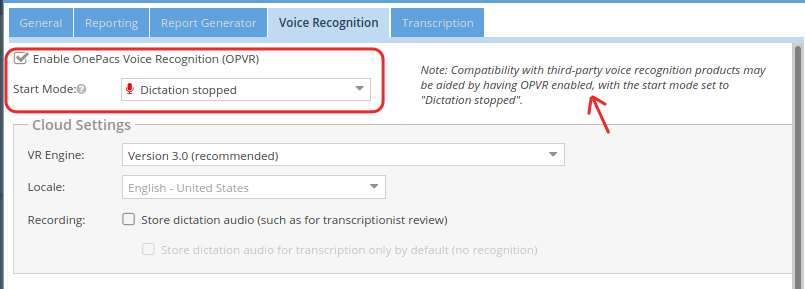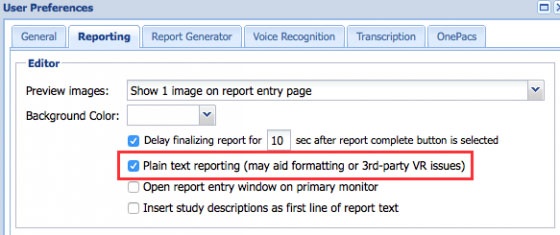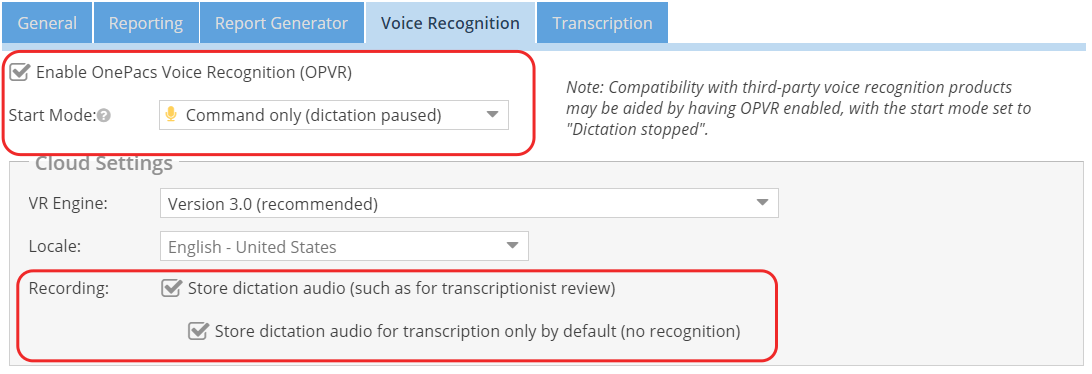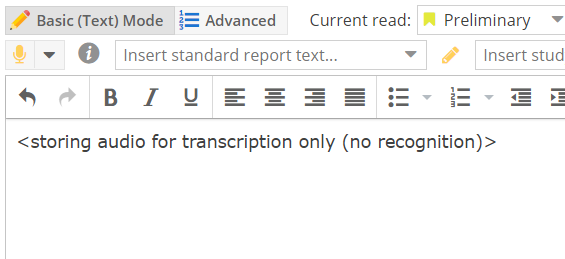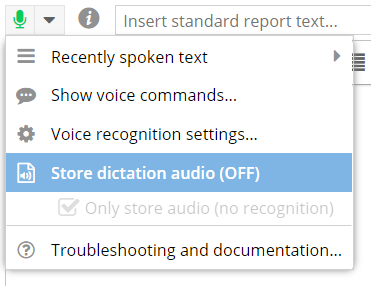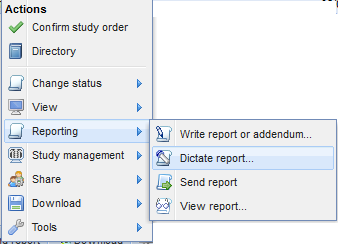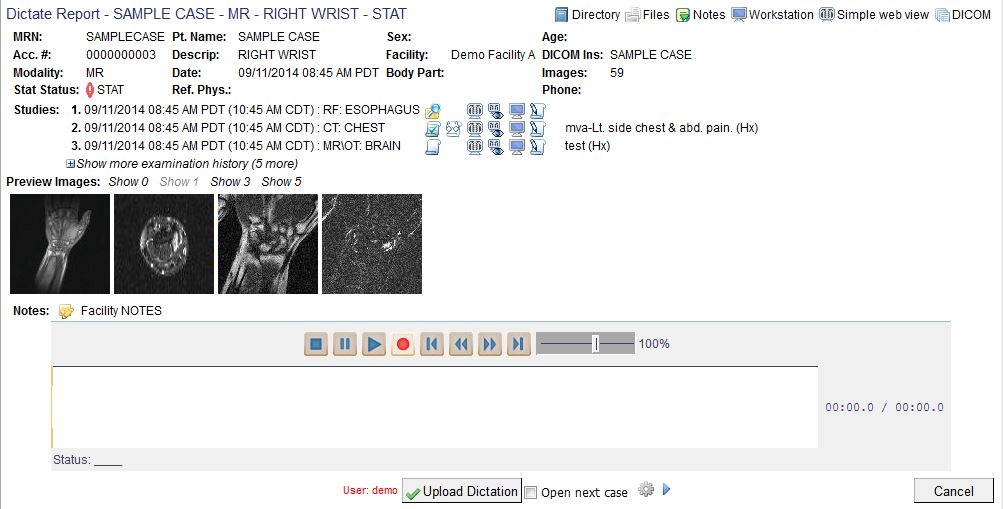Dictating with OnePacs
Voice recognition
Computer-based voice recognition for radiology reporting has become extremely accurate and due to the substantial cost savings compared with transcription services, is the preferred method of report dictation for many radiologists.
Recommended packages
The following voice recognition packages are recommended for use with OnePacs.
OnePacs Voice Recognition
OnePacs offers its own voice recognition solution (OPVR Cloud), which is tightly integrated into the OnePacs reporting system. OPVR is built into the Cloud Report Editor and does not require installation or training. Documentation can be found here.
Third Party Voice Recognition Products
Certain third-party voice recognition solutions can be seamlessly integrated with the OnePacs Cloud Report editor using the OnePacs third party VR integration feature. This means that dictation can be captured and directed to the currently active reporting window, regardless of whether or not the reporting window is in focus; e.g., users may dictate while viewing studies in the DICOM viewer, interacting with the DICOM viewer while text is directed to the reporting window.
While OnePacs allows the use of 3rd party voice recognition products, the best level of integration remains OPVR Cloud. Features such as saving of audio files, certain voice command, and others may not be supported when using a 3rd party product.
M*Modal
M*Modal's Fluency Direct product may be used with OnePacs and supports both mac OS and Microsoft Windows. It may be used stand-alone together with OnePacs, though maximal compatibility is ensured by using the OnePacs third party VR integration feature. When using Fluency Direct with OnePacs without the OnePacs third party integration feature active, the Fluency Direct browser extension for Dragon compatibility should be installed.
Dragon Medical One
Dragon medical one from Nuance is a cloud-based voice recognition solution provided by Nuance. It may be used stand-alone together with OnePacs, though maximal compatibility is ensured by using the OnePacs third party VR integration feature. When using Dragon with OnePacs without the OnePacs third party integration feature active, Nuance's browser extension for Dragon compatibility should be installed. The "General Medicine" topic is suitable for use with radiology reporting.
nVoq "Say it"
Some groups using OnePacs utilize the nVoq "Say it" medical speech recognition solution.
*Note: Fluency DirectTM by M-Modal, Dragon Medical OneTM by Nuance, and Say ItTM by nVoq are third party products which may be used for dictation with the OnePacs system; no endorsement of or affiliation with the OnePacs system by these companies or products is implied.
Third party VR compatibility with the Cloud Report Editor
When using third party VR products with OnePacs, maximal compatibility is ensured by using the OnePacs third party VR integration feature.
If third party VR products are used without the direct integration feature, compatibility may be aided by having OnePacs voice recognition set to ON, but with the microphone state set to "stopped".
Third party VR compatibility with the Classic Report Editor
When using OnePacs Classic Voice Recognition, or a third party voice recognition software package, it is recommended that users enter reports in plain-text mode, to facilitate voice recognition-based formatting or editing and navigation features.
To do so, first access reporting preferences either from the general “User Preferences” item in the “Options” menu on the main OnePacs worklist page, or by clicking on the gear icon in the upper right hand corner of the OnePacs report window.
The option to be selected appears as follows:
To confirm that you are reporting in plain text mode, check for the presence of a rich text editing toolbar at the top of the report edit field (it will be absent in plain text mode):
Using Dragon Medical Practice Edition while reviewing cases
Hidden mode
If the computer on which dictation is being performed is also the PC which is being used for case review, one may use the hidden mode feature of Dragon Medical Practice Edition to enable simultaneous dictation while reviewing cases. To use this feature, say the words “hidden mode on” when you wish to enter hidden mode. Your dictation from that point onwards will be recognized by Dragon, but rather than “typed” immediately, it will be stored for later use. After you have finished case review, place the cursor in the location where you wish the recognized text to be pasted, and say the words “transfer text”. The results of your dictation during the time hidden mode was on will be pasted at the cursor location.
A video demonstrating use of this feature is available here.
Choice of microphone
Any standard voice-recognition grade microphone will work with either of the above described dictation methods in OnePacs.
For users using the Dragon Medical Professional package, Nuance offers a microphone with user-programmable buttons, which can control dictation functions from the handset. This device is called the PowerMic and is described here:
http://shop.nuance.com/store/nuanceus/en_US/pd/productID.139321300
http://speechrecsolutions.com/microphones_dictaphone.html
A variety of other microphones are available from a number of on-line vendors, including:
http://speechrecsolutions.com/
http://www.speechtechnology.com/microphones/
http://www.emicrophones.com/
One vendor offers an online guide to microphone selection:
http://speechrecsolutions.com/microphone_selection_guide.htm
A popular option for users who prefer hands-free dictation is the Buddy Flamingo stand-alone microphone:
http://speechrecsolutions.com/microphones_buddy.html
Voice Recording for Manual Transcription
The OnePacs cloud reporting system contains a facility for saving audio files, without voice recognition, which are attached to the case and can be listened to by transcriptionists for the purpose of transcribing cases. This can be used in conjunction with the proofreading workflow.
In order to use this feature, enable OnePacs Voice Recognition in user settings, and enable the "Store audio files" feature. To suppress recognition of text by OPVR, you may additionally select the "Only store audio" option. The microphone should be set to an enabled state such as "Command mode only":
When this is done, and the report is completed or a draft is saved, an audio file will be available through the "study files" feature, which can be played in-browser:
It is also possible to toggle the audio storage options on the fly while dictating cases, rather than setting them as a default preference:
Audio files are retained for a period of 60 days, after which they will be automatically deleted. The audio files are intended to be used for transcription into a written report and accordingly are not retained indefinitely. Users can download the audio for any particular study if they wish to retain the audio for that study.
The audio files are available to users who have view access for the case in question, and who additionally meet one of the following criteria: the case is assigned to them, they produced the audio file themselves, or their user type is Administrator, Transcriptionist, or Radiology Assistant.
Legacy Voice Recording and Manual Transcription (deprecated)
Deprecated Feature
OnePacs users are advised to cease use of this deprecated method, and instead use the store audio feature of OnePacs Voice Recognition, described in the previous section of this document.
The manual dictation/transcription feature has been deprecated because this feature depends upon an in-browser Java applet, and all major browsers either have already, or have announced that they soon will, end support for in-browser Java applets. Accordingly, this feature is deprecated and the availability of this feature is not guaranteed going forward.
